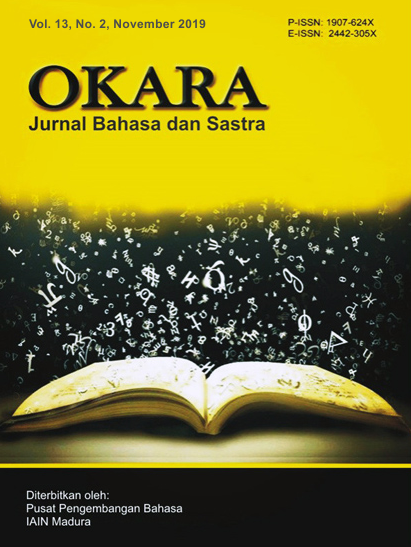Working Memory Role on Gender towards Language Transfer: Study of Neurolinguistics
 Abstract views: 491
,
Abstract views: 491
,
 PDF downloads: 349
PDF downloads: 349
Abstract
Second language acquisition requires many aspects including how the working memory supports the system of the human input system. Working memory has a crucial identity in storing information for a short time. It is a limited complex ability required for holding and manipulating information in a brief period for learning, thinking, giving attention, counting, memorizing, comprehending, and problem-solving. The aims of this research are to predict the role of working memory capacity on males and females and to identify the language transfer in between. The subject of this research consisted of 14 Indonesian students (7 male 7 female) at International Islamic University Malaysia (IIUM). They are signed as postgraduate students of many different majors. Data were taken by using the reading span test of Ronnberg version. Data were analyzed by referring to Baddeley, Hitch, and Ellis. The finding of the research declares that difference gender has different working memory capacity pattern and language transfer. Gender is also a crucial factor in improving second language acquisition.
Downloads
References
Alahmadi, Nasreen Saud, and Radia Kesseiri. “Language Transfer and Grammatical Speaking Errors among Saudi Students.” Arab World English Journal 4, no. 3 (2013): 251–65.
Baddeley, Alan D. “Working Memory.” In Psychology of Learning and Motivation, 8:311–24. Phil. TrNA. R. Soc. Lond. B302. New York: Academic Press, 1983. https://doi.org/10.1016/S0079-7421(08)60452-1.
Baddeley, Alan D., and Graham Hitch. “Working Memory.” In Psychology of Learning and Motivation, edited by Gordon H. Bower, 8:47–89. New York: Academic Press, 1974. https://doi.org/10.1016/S0079-7421(08)60452-1.
Bergsleithner, Joara Martin. “The Role of Noticing and Working Memory Capacity in L2 Oral.” In Organon, Porto Alegre, N251, 217–43, 2011. https://doi.org/10.22456/2238-8915.28841.
Chomsky, Noam. Language and Mind. Cambridge: Cambridge University Press, 2006.
Diamond, Adele. “Executive Functions.” Annual Review of Psychology 64, no. 1 (January 2, 2013): 135–68. https://doi.org/10.1146/annurev-psych-113011-143750.
Ellis, Rod. The Study of Second Language Acquisition. New York: Oxford University Press, 1994.
———. The Study of Second Language Acquisition. 2nd ed. Oxford: Oxford University Press, 2006.
Guará-Tavares, Maria da Glória. “Working Memory Capacity and L2 Speech Performance in Planned and Spontaneous Conditions: A Correlational Analysis.” Trabalhos Em Linguística Aplicada 52, no. 1 (June 2013): 09–29. https://doi.org/10.1590/S0103-18132013000100002.
Hakim, Ruri Fadhilla. “Interferensi Dalam Bahasa Jepang ditinjau dari Kapasitas Working Memory Otak: Suatu Kajian Neurolinguistik.” Thesis, Andalas University, 2015.
Hill, Ashley C., Angela R. Laird, and Jennifer L. Robinson. “Gender Differences in Working Memory Networks: A Brain Map Meta-Analysis.” Biological Psychology 102 (October 2014): 18–29. https://doi.org/10.1016/j.biopsycho.2014.06.008.
Jam, Bashir, Masood Rahimi Domakani, and Zahra Asghari Kasegari. “An Intralingual Analysis of Iranian EFL Learners’ Difficulties Caused by the Inconsistency between Spelling and Pronunciation.” International Journal of Educational Investigations 1, no. 1 (2014): 134–47.
Karim, Khaled, and Hossein Nassaji. “First Language Transfer in Second Language Writing: An Examination of Current Research.” Iranian Journal of Language Teaching Research 1, no. 1 (January 2013): 117–34.
“Kemampuan Bahasa Inggris Warga Indonesia di Bawah Rata-Rata | Republika Online.” Accessed December 14, 2018. https://www.republika.co.id/berita/nasional/umum/18/12/14/pjq0na349-kemampuan-bahasa-inggris-warga-indonesia-di-bawah-ratarata.
Leung, Cynthia Leung, and Alejandro Brice. “An Analysis of Phonological Processes Involved in Spoken English of Hong Kong Primary Pre-Service Teachers.” Language Testing in Asia 2, no. 2 (May 2012): 1–18. https://doi.org/10.1186/2229-0443-2-2-42.
Majerus, Steve. “Working Memory Treatment in Aphasia: A Theoretical and Quantitative Review.” Journal of Neurolinguistics, Short-term and working memory deficits in aphasia: Current issues in theory, evidence, and treatment, 48 (November 1, 2018): 157–75. https://doi.org/10.1016/j.jneuroling.2017.12.001.
Marwati, Sofia. “An Analysis of Error-Pronouncing Phonemes Caused by Interference as Found in Spoken English of the First Year Students at the English Department of Andalas University and Some Universities in Melbourne.” Thesis, Universitas Andalas, 2016.
Rönnberg, Jerker, Stig Arlinger, Björn Lyxell, and C Kinnefors. “Visual Evoked Potentials: Relation to Adult Speechreading and Cognitive Function.” Journal of Speech and Hearing Research 32, no. 4 (December 1, 1989): 725–35. https://doi.org/10.1044/jshr.3204.725.
Sastra, Gusdi. Neurolinguistik Suatu Pengantar. Bandung: Alfabeta, 2010.
Service, Elisabet, Marjut Simola, Oili Metsänheimo, and Sini Maury. “Bilingual Working Memory Span Is Affected by Language Skill.” European Journal of Cognitive Psychology 14, no. 3 (July 2002): 383–408. https://doi.org/10.1080/09541440143000140.
Speck, Oliver, Thomas Ernst, Jochen Braun, Christoph Koch, Eric Miller, and Linda Chang. “Gender Differences in the Functional Organization of the Brain for Working Memory:” NeuroReport 11, no. 11 (August 2000): 2581–85. https://doi.org/10.1097/00001756-200008030-00046.
“Umur Berapa Otak Manusia Berkembang Optimal?” Accessed September 30, 2019. https://health.detik.com/berita-detikhealth/d-1528647/umur-berapa-otak-manusia-berkembang-optimal.
Utami, Agustina Ridho, and Noor Malihah. “Speech Errors Produced by EFL Learners of Islamic Boarding School in Telling English Story.” OKARA: Jurnal Bahasa dan Sastra 12, no. 2 (November 30, 2018): 191–200. https://doi.org/10.19105/ojbs.v12i2.1930.
The journal operates an Open Access policy under a Creative Commons Attribution-NonCommercial 4.0 International License. Authors who publish with this journal agree to the following terms:
- Authors retain copyright and grant the journal right of first publication with the work simultaneously licensed under a Creative Commons Attribution License that allows others to share the work with an acknowledgement of the work's authorship and initial publication in this journal.
- Authors are able to enter into separate, additional contractual arrangements for the non-exclusive distribution of the journal's published version of the work (e.g., post it to an institutional repository or publish it in a book), with an acknowledgement of its initial publication in this journal.
- Authors are permitted and encouraged to post their work online (e.g., in institutional repositories or on their website) prior to and during the submission process, as it can lead to productive exchanges, as well as earlier and greater citation of published work.





_(1).png)
.png)
.png)
1.png)
.png)
.png)

.png)
_-_Copy_-_Copy.png)





